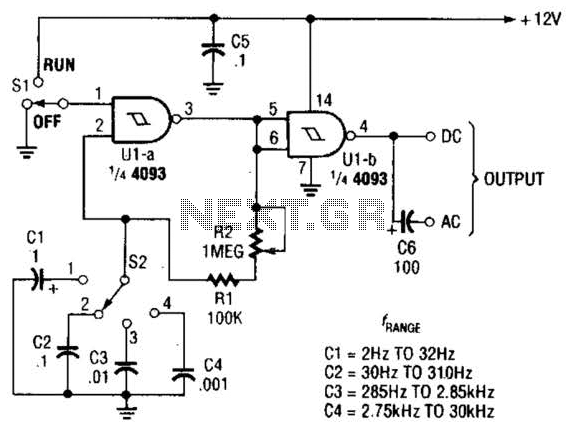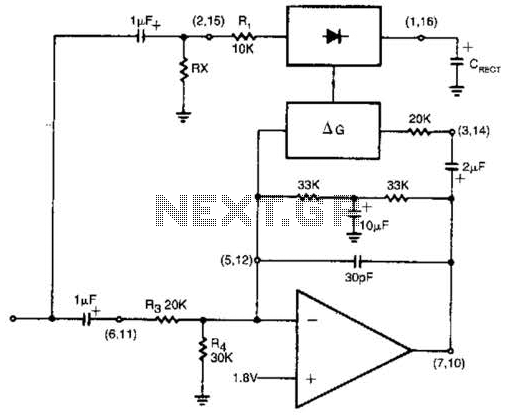
Perfect Pitch Circuit

Perfect Pitch, which is based on the 8751 microprocessor, is an affordable and straightforward instrument tuner and frequency counter that features a built-in headphone amplifier and a visual metronome. Perfect Pitch converts the audio signal from an instrument into a digital signal, displaying the musical note being played and its frequency in real time on a 16-character liquid crystal display. Additionally, it includes an auxiliary audio input for connecting radio, tape, or CD players, allowing users to tune their instruments while playing along with their favorite artists.
The Perfect Pitch tuner utilizes the 8751 microprocessor, which is integral to its functionality. The microprocessor processes the incoming audio signals from the instrument or auxiliary input, converting them into a digital format. The audio signal is captured through a microphone or line input, where it undergoes analog-to-digital conversion (ADC) to facilitate accurate frequency analysis. The processed data is then analyzed to determine the fundamental frequency of the audio signal, which corresponds to the musical note being played.
The results of this analysis are displayed on a 16-character liquid crystal display (LCD), providing real-time feedback to the user. The LCD is interfaced with the microprocessor, and it presents both the note name (e.g., A, B, C♯) and its frequency in Hertz (Hz). This feature is particularly useful for musicians who require precise tuning to achieve perfect pitch.
In addition to its primary function as a tuner, Perfect Pitch incorporates a visual metronome. This feature assists musicians in maintaining consistent tempo during practice or performance. The metronome can be adjusted for different beats per minute (BPM), providing audible and visual cues to help users stay in time.
The auxiliary audio input expands the versatility of the device, allowing it to connect to external audio sources such as radios, tape players, or CD players. This feature enables musicians to play along with recorded music, enhancing their practice sessions and musical enjoyment. The input circuitry is designed to handle a range of audio levels, ensuring compatibility with various devices.
Overall, the Perfect Pitch tuner is a valuable tool for musicians, offering an affordable, user-friendly solution for tuning instruments and enhancing practice through its built-in features. Its combination of digital signal processing, real-time display, and auxiliary input makes it a comprehensive instrument for both novice and experienced musicians. Perfect pitch, which is based on the 8751 microprocessor, is an inexpensive and easy-to-build instrument tuner/frequency counter with a built-in headphone amplifier and a visual metronome. Perfect pitch converts the audio signal from your instrument to a digital signal, and displays the musical note you are playing and its frequency in real time on a 16-character liquid-crystal display.
It also has an auxiliary audio input for radio, tape, or CD players so that you can tune up and play along with your favorite artists.
The Perfect Pitch tuner utilizes the 8751 microprocessor, which is integral to its functionality. The microprocessor processes the incoming audio signals from the instrument or auxiliary input, converting them into a digital format. The audio signal is captured through a microphone or line input, where it undergoes analog-to-digital conversion (ADC) to facilitate accurate frequency analysis. The processed data is then analyzed to determine the fundamental frequency of the audio signal, which corresponds to the musical note being played.
The results of this analysis are displayed on a 16-character liquid crystal display (LCD), providing real-time feedback to the user. The LCD is interfaced with the microprocessor, and it presents both the note name (e.g., A, B, C♯) and its frequency in Hertz (Hz). This feature is particularly useful for musicians who require precise tuning to achieve perfect pitch.
In addition to its primary function as a tuner, Perfect Pitch incorporates a visual metronome. This feature assists musicians in maintaining consistent tempo during practice or performance. The metronome can be adjusted for different beats per minute (BPM), providing audible and visual cues to help users stay in time.
The auxiliary audio input expands the versatility of the device, allowing it to connect to external audio sources such as radios, tape players, or CD players. This feature enables musicians to play along with recorded music, enhancing their practice sessions and musical enjoyment. The input circuitry is designed to handle a range of audio levels, ensuring compatibility with various devices.
Overall, the Perfect Pitch tuner is a valuable tool for musicians, offering an affordable, user-friendly solution for tuning instruments and enhancing practice through its built-in features. Its combination of digital signal processing, real-time display, and auxiliary input makes it a comprehensive instrument for both novice and experienced musicians. Perfect pitch, which is based on the 8751 microprocessor, is an inexpensive and easy-to-build instrument tuner/frequency counter with a built-in headphone amplifier and a visual metronome. Perfect pitch converts the audio signal from your instrument to a digital signal, and displays the musical note you are playing and its frequency in real time on a 16-character liquid-crystal display.
It also has an auxiliary audio input for radio, tape, or CD players so that you can tune up and play along with your favorite artists.





